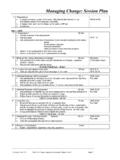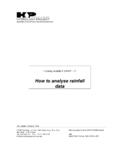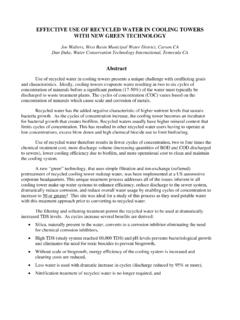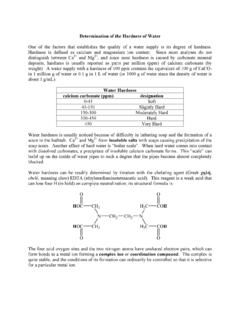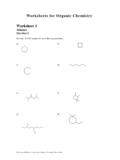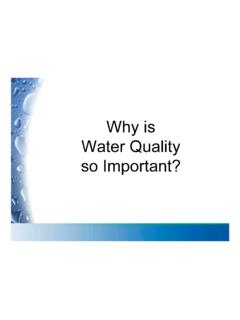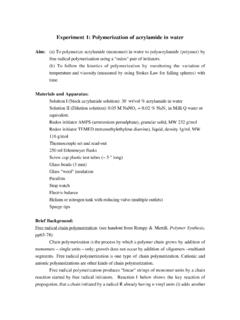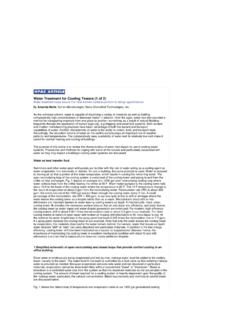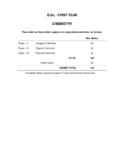Transcription of Basic chemistry concepts - Central Water Commission
1 World Bank & Government of The Netherlands fundedTraining module # WQ I-2 Basic chemistry conceptsNew Delhi, May 1999 CSMRS Building, 4th Floor, Olof Palme Marg, Hauz Khas,New Delhi 11 00 16 IndiaTel: 68 61 681 / 84 Fax: (+ 91 11) 68 61 685E-Mail: Consultants BV & DELFT HYDRAULICS withHALCROW, TAHAL, CES, ORG & JPSH ydrology Project Training Module File: 02 Basic chemistry Version 05/11/02 Page 1 Table of contentsPage1 Module context22 Module profile33 Session plan44 Overhead/flipchart masters55 Evaluation256 Handouts277 Additional handouts368 Main text39 Hydrology Project Training Module File: 02 Basic chemistry Version 05/11/02 Page 21 Module contextThis module introduces Basic concepts of chemistry required by chemists at all levels in theirdaily work in the laboratory. No prior training in other module is needed to complete thismodule Project Training Module File: 02 Basic chemistry Version 05/11/02 Page 32 Module profileTitle: Basic chemistry conceptsTarget group:As per training needDuration:One session of 90 minObjectives:After the training the participants will be able to: Convert units from one to another Discuss the Basic concepts of quantitative chemistry Report analytical results with the correct number ofsignificant concepts : SI units and symbols Elements compounds and radicals Equivalent weights Principles of titration Significant figuresTraining methods:Lecture, exercisesTraining toolsrequired:Board, flipchart, OHSH andouts:As provided in this moduleFurther readingand references: Analytical chemistry : An introduction, Skoog and West/1986.
2 Saunders College Publishing chemistry of Environment Engineering, C. N. Sawyer, McCarty and Parkin. McGraw-Hill, 1994 Hydrology Project Training Module File: 02 Basic chemistry Version 05/11/02 Page 43 Session planNoActivitiesTimeTools1 Preparations2 Introduction: Basic chemistry concepts5 minOHS3 Units of measurement Introduce the subject of units of measurementand the importance of standardisation of units. Demonstrate how to calculate theconcentration of substances in liquids andhow to convert units. Explain and emphasise use of factor minMain textTables 1 & 2 OHS4 Ions, molecules and molecular weights Describe the concept of ion charge, neutralityof molecules and molecular minMain textTables 3 & 4 OHS5 Equivalent weights Explain the concept , determination and use ofequivalent weights emphasising factor minMain textTables 3 & 4 OHS6 Standard solutions and titrimetric methods Define standard solutions and describetitrimetric method of again the use of factor label method inall minOHS7 Significant figures Explain importance of reporting data insignificant minOHS8 Exercise Ask participants to answer the questions inthe handout Distribute exercise sheets as additionalhandouts10 minExercise sheetSolution sheet9 Wrap up Distribute & discuss answers.
3 Refer to additional questions for homework10 minHydrology Project Training Module File: 02 Basic chemistry Version 05/11/02 Page 54 Overhead/flipchart mastersOHS format guidelinesType of textStyleSettingHeadings:OHS-TitleArial 30-36, Bold with bottom border line (not:underline)Text:OHS-lev1 OHS-lev2 Arial 26,Arial 24, with indentmaximum two levels onlyCase:Sentence case. Avoid full text in :Use occasionally and in a consistent wayListings:OHS-lev1 OHS-lev1-NumberedBig for definite series of steps. Avoidroman numbers and :None, as these get lost in photocopying andsome colours do not reproduce at of a table will ease alignment over morelines (rows and columns)Use equation editor for advanced formattingonlyHydrology Project Training Module File: 02 Basic chemistry Version 05/11/02 Page 7 Basic chemistry concepts1. Units of measurement2. Elements, compounds and molecular weights3. Equivalent weights and chemical reactions4. Titrimetric calculations5. Significant figuresHydrology Project Training Module File: 02 Basic chemistry Version 05/11/02 Page 81.
4 Units of measurementSee table 1 & 2 in HandoutHydrology Project Training Module File: 02 Basic chemistry Version 05/11/02 Page 91. Units of measurement: concentration unitsExample:Four kg common salt is thrown in a tank containing 800 m3 ofwater. What is the resulting concentration of salt in mg / L?4 kg106 mg1 m34106mg= -------- x ------- x -----=---- x ----- x----800 m31 kg103 L800103 Lmg=5 ----LHydrology Project Training Module File: 02 Basic chemistry Version 05/11/02 Page 101. Units of measurement: conversion of unitsExample (Factor - label method):Convert 5mg/L into g/Lmgmg1000 g5 ----=5 ----x ---------LL1 mg g=5000 ----LHydrology Project Training Module File: 02 Basic chemistry Version 05/11/02 Page 112. Elements, compounds & molecular weights Elements combine to make compounds which do not haveany net charge Compounds dissolved in Water dissociate into chargedions Radicals are groupings of elements acting together ascharged ionsSee Table 3 & 4 in handoutHydrology Project Training Module File: 02 Basic chemistry Version 05/11/02 Page 122.
5 Elements, compounds & molecular weightsExample:Write the molecular formula for aluminium sulphate (alum) ifeach molecule has 18 molecules of Water of of +ive charges on 2Al3+ = 6No. of -ive charges on 3SO42-= 6 The formula is Al2(SO4) Project Training Module File: 02 Basic chemistry Version 05/11/02 Page 132. Elements, compounds & molecular weightsExample:Calculate the molecular weight of alum Al2(SO4) andits sulphur +++=2 x 27 = 543SO4--=3x96=28818H2O = 18x18=324 Total =66632 Sulphur content: 3 X----= Project Training Module File: 02 Basic chemistry Version 05/11/02 Page 143. Equivalent weight Molecular weight / Valency Valency is equal to:- absolute number of ion charge- number of H+ or OH- ions that can combine with the ion- absolute number of change in charge of ion in a reaction Quantity of chemicals equivalent to each other One chemical expressed as another Same number of equivalents of reactants in a chemicalreactionHydrology Project Training Module File: 02 Basic chemistry Version 05/11/02 Page 153.
6 Equivalent weightExample: Express 120 mg Ca++ / L as mg CaCO3/L- Equivalent weight of Ca++= 20- Equivalent weight of CaCO3= 50mg Ca++mg Ca++1 meq50mg CaCO3120 -----------=120 -----------x------------x-------------LL 20mg Ca++1meqmg CaCO3=300--------------LHydrology Project Training Module File: 02 Basic chemistry Version 05/11/02 Page 163. Equivalent weightExample: for the balanced reaction2 NaOH + H2SO4=Na2SO4+2H2O- 2 moles NaOH react with 1 mole H2SO4- 80g NaOH react with 98g H2SO4- 2eq NaOH react with 2 eq H2SO4 Hydrology Project Training Module File: 02 Basic chemistry Version 05/11/02 Page 174. Titrimetric method Standard solutions contain known concentration of onereactant 1 N solution contains 1 eq wt/L React standard solution against unknown concentration insample End point is determined using indicator Eq of reactant in standard = Eq of reactant in sampleHydrology Project Training Module File: 02 Basic chemistry Version 05/11/02 Page 184. Titrimetric methodExample:Calculate the alkalinity of a sample if 50 mL aliquotconsumed mL of standard acid alkalinity=-----------50mLHydrology Project Training Module File: 02 Basic chemistry Version 05/11/02 Page 194.
7 Titrimetric methodExample (Contd.):Expressed as CaCO3=----------x---------x------------- ---50mL1L1meqmg CaCO3=1240-------------LHydrology Project Training Module File: 02 Basic chemistry Version 05/11/02 Page 205. Significant figures Significant figures in a number comprise- digits about which there is no uncertainty- one last digit which has uncertainty Round off by dropping digits that are not significant- if a digit > 5 is dropped, increase preceding digit by 1- if a digit < 5 is dropped, leave preceding digit unchanged- if digit 5 is dropped, round off preceding digit to nearest even numberHydrology Project Training Module File: 02 Basic chemistry Version 05/11/02 Page 215. Significant figures Addition/Subtraction: results have the same decimalplaces as the number added/ subtracted with the leastdecimal placesExample0 007212 02+488500 0272 500 Hydrology Project Training Module File: 02 Basic chemistry Version 05/11/02 Page 225. Significant figures Multiplication/Division: results have the same number ofsignificant places as the number multiplying/dividing withthe least significant 003462x43 22-------------------------------------- -=4 975740998 5 01 684 Hydrology Project Training Module File: 02 Basic chemistry Version 05/11/02 Page 23 Exercise1.
8 Express m/s velocity in km/d2. Calculate the normality of a Ba(OH)2 solution if mLwere needed to neutralise mL of N How many significant figures are there in , , 7500, +3, , Project Training Module File: 02 Basic chemistry Version 05/11/02 Page 24 Basic chemistry concepts1. Units of measurement2. Elements, compounds and molecular weights3. Equivalent weights and chemical reactions4. Titrimetric calculations5. Significant figuresHydrology Project Training Module File: 02 Basic chemistry Version 05/11/02 Page 255 EvaluationHydrology Project Training Module File: 02 Basic chemistry Version 05/11/02 Page 26 Additional questions Write chemical formulas for: (a) magnesium hydroxide, (b) trihydrogen orthophosphate,(c) calcium hypochlorite, (d) barium sulphate, (e) ammonium carbonate. Calculate the quantities of chemicals needed to prepare the following solutions: (a) oneL of CaSO4, (b) 250 mL of MgCO3, (c) L of 4M (NH4)2CO3. Express: (a) 272 mg/L CaSO4 as CaCO3, (b) 280 (g/L as g/m3, (c) 40 kg/m3 as mg/L.)
9 Calculate quantity of sulphuric acid present in: (a) 12 mL of solution, (b) 10 L solution. Chloride in Water is determined by precipitating it with standard silver nitrate the concentration of chloride in a sample of Water if 12 mL of AgNO3was required to react with 50 mL of Water sample. How many significant figures are there in , , x 10, 4 x 10, Express the result in correct number of significant digits: (a) 124 , (b) 23 + + Project Training Module File: 02 Basic chemistry Version 05/11/02 Page 276 HandoutsHydrology Project Training Module File: 02 Basic chemistry Version 05/11/02 Page 28 Basic chemistry concepts1. Units of measurement2. Elements, compounds and molecular weights3. Equivalent weights and chemical reactions4. Titrimetric calculations5. Significant figures1. Units of measurementSee table 1 & 2 in HandoutHydrology Project Training Module File: 02 Basic chemistry Version 05/11/02 Page 291.
10 Units of measurement: Concentration unitsExample:Four kg common salt is thrown in a tank containing 800 m3 of Water . What is theresulting concentration of salt in mg / L?4 kg106 mg1 m34106mg=--------x-------x-----= ----x-----x ----800 m31 kg103 L800103 Lmg=5----LExample (Factor - label method):Convert 5mg/L into g/Lmgmg1000 g5----=5----x---------LL1 mg g=5000----L2. Elements, compounds & molecular weights Elements combine to make compounds which do not have any net charge Compounds dissolved in Water dissociate into charged ions Radicals are groupings of elements acting together as charged ionsSee Table 3 & 4 in handoutHydrology Project Training Module File: 02 Basic chemistry Version 05/11/02 Page 302. Elements, compounds & molecular weightsExample:Write the molecular formula for aluminium sulphate (alum) if each molecule has 18molecules of Water of No. of +ive charges on 3SO42- = 6- No. of -ive charges on 3SO42- = 6 The formula is Al2(SO4) :Calculate the molecular weight of alum Al2(SO4) and its sulphur +++=2x 27= 543SO4--=3x96=28818H2O=18x18=324 Total=66632 Sulphur content: 3 X----= Equivalent weight Molecular weight / Valency Valency is equal to:- absolute number of ion charge- number of H+ or OH- ions that can combine with the ion- absolute number of change in charge of ion in a reaction Quantity of chemicals equivalent to each other One chemical expressed as another Same number of equivalents of reactants in a chemical reactionExample: Express 120 mg Ca++ / L as mg CaCO3/LEquivalent weight of Ca++= 20 Equivalent weight of CaCO3= 50mg Ca++mg Ca++1 meq50mg CaCO3120-----------=120-----------x----- -------x-------------LL20mg Ca++1meqmg CaCO3=300--------------LHydrology Project Training Module File: 02 Basic chemistry Version 05/11/02 Page 313.




